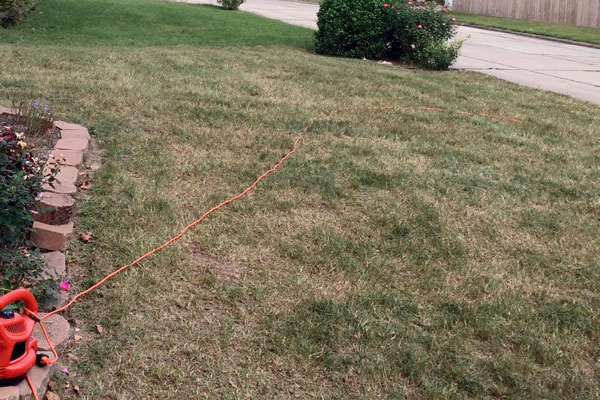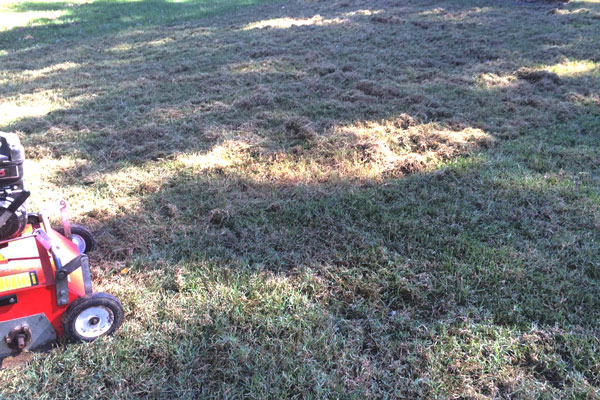Taking an environmentally sensitive approach to pest management
It's Go Time for Fall Recovery on Lawns
Published: September 15, 2017
Mild temperatures have been screaming "GO!" to tall fescue and Kentucky bluegrass for much of the month of August, well ahead of the revered mid-September date for aerification, fertilization, and overseeding. Average two-inch soil temperatures are hovering around the mid to 70s for much of the state, and we are down to 13 hours of daylight to keep things cool.
These cool temperatures of fall provide the best time for building a lawn. The stress and disease potential of the summer is in the rearview mirror instead of the windshield, and even troublesome weeds are either ready to kick the bucket (summer annuals) or are pulling in the reins to make it through the winter. At the same time, cool season grasses are kicking it back into gear, wiping the sweat of their brow after a long workout, and are ready to put on some muscle. Our job is to put food on their plate and give them room to grow. Below are a few bullet points of ways to get a healthy lawn going for next spring. If you use a professional service for lawn care, make sure to discuss with them the routine care needs (particularly irrigation) that will be necessary to ensure success of their efforts.
- The first and most crucially important question is "Do you know the size of your lawn?" If not, you shouldn't be a DIYer when it comes to fertilization, seeding, or chemical applications. A new tool, the Missouri Lawn Fertilizer calculator - http://agebb.missouri.edu/fertcalc/, requires this information and provides a link to a map application that can assist in determining your lawn area.
- Fertilization — If nothing else, fertilize the lawn in the next few weeks to put on that "muscle mass" and start competing. Fall is the best time to fertilize because there is much less danger of sparking troublesome warm weather diseases such as brown patch and Pythium blight. On established lawns, plan for at least 1 lb N/1000 sq ft, and for newer lawns a bit more. (again see the Missouri Lawn Fertilizer Calculator mentioned above). Quick release forms such as urea will serve the purpose, but perhaps split into two applications for a steadier feed (and remember to water it in). If overseeding a lawn or renovating (i.e. starting from scratch), a balanced starter fertilizer may be needed. Conduct a soil test prior to renovating to determine plant needs - http://soilplantlab.missouri.edu. After fertilization (and mowing), use a leaf blower to get fertilizer & material off impervious surfaces such as driveways and gutters and back on your lawn. Our lakes, streams, and waterways will be most appreciative of this method of pollution reduction.

After power-raking seeding, and fertilizing. Note the leaf blower used to get fertilizer, seed, and plant material off the street/driveway and back into lawn!
- Weed Control — Fall is the best time for long term control of most perennial broadleaves with herbicides since the plants are pulling in nutrients for storage rather than pushing out new growth. We need to strategize, however, the best timing for doing this, particularly if we plan to overseed. If seeding this fall, spot applications of glyphosate may work best for a small area since reseeding can be done just a few days after. If going after broadleaves with a 3-way type herbicide or triclopyr, it may be best to seed now, assess the establishment of the stand, and apply in mid to late October or wait until next spring. Check the label of your intended product carefully to determine potential impact on seeding efforts, and follow that plan.
- Aerification — If letting seed fly, aerification is a great practice to prepare the site. Aerification also will help produce pathways for water and nutrients to flow down to the rootzone, and does a good job of opening up the canopy to enable some good seed soil contact. A power rake, core or spike aerifier (from most to least effective) should be used over the area prior to seeding.

Example of thatch removal after power-raking (or verticutting) lawn prior to seeding.
- Seeding — If weeds continually produce seeds to establish into bare areas year after year, why don't we also seed in the same way? We have the distinct advantage of being able to seed tall fescue and Kentucky bluegrass, and to build density we should use it. Fall is the best time for seeding, and to do it effectively follow this pattern. Mow low (only time I'll recommend) — aerify — seed — lightly rake in — fertilize — irrigate.
- Irrigation — Irrigation used to establish tall fescue seed in the fall is perhaps more appropriate than supplemental irrigation used throughout the summer to keep tall fescue green. Unfortunately, the only part of the early September weather pattern that doesn't seem to be cooperating with seeding is the lack of rainfall. Hopefully some rainfall will return in mid-September, but don't rely exclusively on it and provide supplemental irrigation. This irrigation will need to be light and frequent, opposite of irrigation practices on an established lawn. In the words of my recently retired colleague, Dr. Brad Fresenburg "keep the soil dark after seeding, but don't make it shiny".
For more information on maintenance of tall fescue and Kentucky bluegrass lawns, see:
http://extension.missouri.edu/p/g6705http://extension.missouri.edu/publications/DisplayPub.aspx?P=G6700
Subscribe to receive similar articles sent directly to your inbox!
- Lawn Seeding Best in September (09/04/24)
- Tomato Production: Ten Common Questions (08/07/23)
- Garden IPM Starts with Fall Cleanup (11/21/22)
REVISED: February 21, 2017